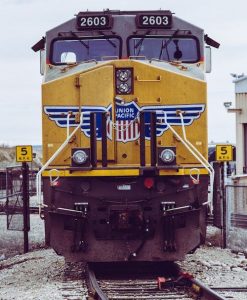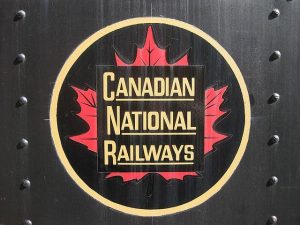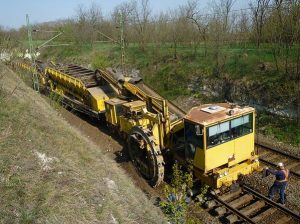
As the United States waited this week for decisions from at least several of 12 labor unions that support freight railroad workers, the Congress weighed in on a dispute that could have had enormous economic consequences for our nation. What long-term effects may be in store for these railroad brands, we cannot say. But it is an opportune time to explore our company’s soon-to-be-released database of thousands of corporate marketing mottos, slogans, and taglines. Since we’re on the subject, let’s look up various phrases that railroads use currently and over the years!
Since the very inception of modern marketing, the slogan has stood as a pinnacle of brand identity. A small assembly of words that work to solidify what your brand has to offer to your customers, marketing catchphrases work to build the history your brand will leave behind. Few markets exemplify this fact more keenly than the railroad industry. With a rich history dating back to the early stages of the industrial revolution, railroad companies have been using snappy and memorable slogans for generations.
Today, we’ll evaluate a number of railroad titans and their catchphrases, what makes them effective, how they’ve been influenced, and more.
Amtrak
If you participated in Quiz Bowl, you may know that the name Amtrak was coined from “AMerican TRAvel TracK“. Amtrak is a relatively young company that began operations in the 1970s and initially struggled to obtain permission to operate passenger trains on freight-dominated tracks.
The federally-backed company has used a wide range of marketing slogans, including:
- 500 Destinations, Infinite Smiles
- America’s Railroad
- Get Carried Away
- Enjoy the Journey
- Just an Amtrak Away
- Making 500 Destinations a Far Better Ride
- See America at See Level
- We’re Making the Trains Worth Traveling Again
- We’re ready when you are — (not to be confused with Delta Air Lines’ use and reuse of a similar phrase)
With so many snappy slogans under its belt, Amtrak has currently settled on “Just an Amtrak Away” as the four words that Americans are supposed to associate with Amtrak’s brand identity. It’s a solid and punchy slogan that connotes convenience, and also suggests distances between (especially Northeastern) cities can be mentally minimized if you’re riding comfortably on the rails.
BNSF (Burlington Northern Santa Fe)
Back in 1849, the Aurora Branch Railroad in Illinois and the Pacific Railroad of Missouri came together to build what would later become BNSF. (No, the “Burlington” isn’t the city in Vermont — it’s the one outside of Chicago.) As far back as 1888, the Burlington & Northern was negotiating with striking engineers who had grievances against the company. And in 1977, when the “BN” acquired the “SF” (Santa Fe Pacific railroad), 2,600 jobs disappeared in consolidating moves. Modern records reflect that the company has only ever used one iconic slogan.
“Be Safe Now” is a motto that highlights the company’s focus on safety and timeliness, which have been cornerstones of the company’s success for generations.
Canadian National Railway
 The history behind the Canadian National Railway is fascinating, centered around the financial disaster of a depressed economy. It was created when the Canadian Crown took over the struggling railroad operators and nationalized them, merging them into what we now know as the Canadian National Railway.
The history behind the Canadian National Railway is fascinating, centered around the financial disaster of a depressed economy. It was created when the Canadian Crown took over the struggling railroad operators and nationalized them, merging them into what we now know as the Canadian National Railway.
Soon after its creation, the Crown used “Serves All Canada” as the railroad’s slogan, a reflection of a more monarch-centered attitude that was common at the time. Yet, as the railroad evolved, and so its country’s government, the slogan was updated to “The People’s Railway.” If you are ever wondering what the “CN” stands for at the tallest freestanding structure in the Western Hemisphere, wonder no more — it’s “Canadian National”.
Canadian Pacific Railway
The Canadian Pacific Railway was launched by the Ottawa government in 1881, with the goal of creating a transcontinental railway. It was completed in 1885 and was the first time in history that Canadians could move goods from east to west on a single track. Did you know that Canadian Pacific also owns track in the northern United States?
The history behind the CPR’s marketing is difficult to find, but early records appear to confirm that the railroad has used the “Spans the World” slogan for a very long time.
CSX
In 1980, Chessie System and Seaboard Coastline merged to become CSX Corp., with headquarters in Richmond, Virginia. Their focus has always been on servicing oil and gas fields, with a range of railroads, barge lines, and trucking operations as logistical support.
Early on, CSX operated under the “Trusted to Move America” slogan, a reflection of their focus on moving valuable goods (on many platforms) vital for American jobs and more luxurious lifestyles. However, in 2008 the company shifted its focus more to the future, changing its tagline to “How Tomorrow Moves.”
Kansas City Southern
Kansas City Southern was founded in 1893 as the Kansas City, Pittsburg, and Gulf Railroad by Kansas City real estate magnate, Arthur E. Stilwell. He eventually extended his network all the way to southern Arkansas by acquiring and expanding a number of smaller lines. Stilwell died just before the Great Depression, so he never saw how that crash would cripple his railroad. The company has stood firm behind its iconic “Route of The Southern Belle” slogan, which is a staple among rail enthusiasts.
Norfolk Southern
Construction began in 1883 on what would become the first section of track for the Norfolk Southern Railroad, connecting the cities of Norfolk, Virginia, and Elizabeth City, North Carolina. The company’s track network now reaches as far as Jacksonville, New Orleans, Kansas City, Detroit, and metropolitan New York.
With such an aggressive expansion, it’s no surprise that Norfolk Southern has branded itself around its slogan “One Line. Infinite Possibilities.” It’s a stoic reflection of the brand’s incredible history and continued industrial success.
Union Pacific
The Union Pacific railroad has a woven history with many of the other entries on this list. Born during the Civil War, the original Union Pacific railroad was an essential part of the transcontinental push of the time. Over the last century, Union Pacific absorbed many smaller railroads to become the border-spanning titan it is today. No other rival spans as much track west of the Mississippi River than Union Pacific.
It feels like Union Pacific takes a certain amount of pride with how many different marketing catchphrases it has introduced.
These include:
- Be Specific, Ship Union Pacific!
- Building America
- Dependable Transportation
- Road of the streamliners
- Serves all the west
- We can handle it
- We’re a great big rolling railroad
- We Will Deliver
It wasn’t until the tenure of the current CEO that the slogan “Building America” became the company’s defining motto. You can see strong parallels with their slogan progression when compared to Amtrak’s history, reflecting evolving business priorities over the decades.
Harsco Rail

The Harrisburg Car Manufacturing Company was established in 1853, and it soon focused on steel materials. In 1956, after many mergers and purchases, the corporation changed its name to Harsco and split into Metals & Minerals, Rail, and Industrial divisions.
The Rail division of Harsco has branded itself around the slogan “Enabling Technology in Motion,” a nod to the company’s multi-faceted technical and industrial roots that may be lost on all but the most dedicated train enthusiasts today. Harsco is approaching the $2 billion annual revenue mark.
Deutsche Bahn
Research Biz’s forthcoming “Phrase Database” of thousands of corporate and product mottos, slogans, and taglines is not limited to only North American companies. In light of that, we couldn’t have a list of railroad slogans without mentioning the iconic Deutsche Bahn, the European colossus of public transport. Despite its enormous reach, Deutsche Bahn is one of the youngest companies on this list, founded in just 1994 — a merger of two state-run networks into one privately-run enterprise. While its owned track is restricted to Germany, DB international routes run to Marseilles, London, Warsaw, and Budapest.
Signaling a new age of railroad transport, Deutsche Bahn defines itself as “Campaigning for Rail”, which is a window into how the company advocates for continued success.
East Japan Railway
In 1987, “JR East” was formally established as a separate entity from its parent company, the government-run Japanese National Railways (JNR). With that split, JR East took over the management of the old JNR lines in the Tokyo metropolitan area and the Tohoku region, making it the largest privately-owned railroad company in Japan. After the Fukushima earthquake and nuclear accident in the Tohoku region of Japan, the East Japan Railway introduced an iconic “Get Back, Tohoku” campaign, which even years later won awards for how moving and beautiful the associated images were.
Other international lines of note
Our Phrase Database even includes straplines from Indian Railways (“Hungry For Cargo” and “Lifeline of the Nation”), France’s SNCF (“For all of us”), and the Russian conglomerate United Transport and Logistics Company (UTLC) which says “One Belt, One Road, One Million”, but manages to connect Eastern Europe to Chinese hubs while notably avoiding any track in the footprint of Ukraine.
Conclusion
With so much history, and a wealth of slogans to explore merely in the railroad industry alone, a useful searchable database to keep track of thousands of global brands’ catchphrases would be a fantastic tool, don’t you think? Please keep an eye open for an announcement when Phrase Database launches!
For our steam, diesel-electric, and all-electric train enthusiasts reading to the end, how do you rate our summary? Did we miss any iconic slogans, or even get one wrong? Perhaps there is an important historical context behind one of these taglines that you’d like to share?
Don’t hesitate to let us know, down below!

